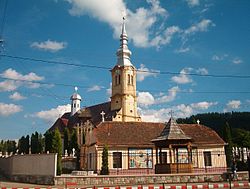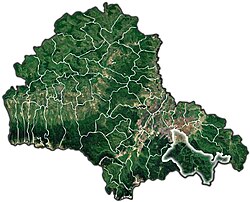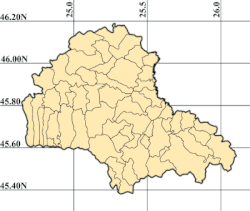Turcheș
|
Săcele Szecseleváros |
|
|---|---|
| Municipality | |
 |
|
 Location of Săcele |
|
 Location in Brașov County |
|
| Location of Săcele | |
| Coordinates: 45°37′12″N 25°42′35″E / 45.62000°N 25.70972°ECoordinates: 45°37′12″N 25°42′35″E / 45.62000°N 25.70972°E | |
| Country |
|
| County | Brașov County |
| Status | Municipality |
| Government | |
| • Mayor | Popa Virgil (Social Democratic Party) |
| Area | |
| • Total | 320 km2 (120 sq mi) |
| Lowest elevation | 650 m (2,130 ft) |
| Population (2002) | |
| • Total | 30,043 |
| Time zone | EET (UTC+2) |
| • Summer (DST) | EEST (UTC+3) |
| Website | http://www.municipiulsacele.ro/ |
Săcele (Romanian pronunciation: [səˈt͡ʃele]; German: Siebendörfer; Hungarian: Négyfalu, formerly Szecseleváros) is a city in Brașov County, Romania, in the region of Transylvania, with a population of 29,915 inhabitants in 2002. It is practically adjacent to the city of Brașov, its city centre being situated 15 km away from downtown Brașov.
The city since 1950 is composed of former villages which now form the main sectors: Baciu (Bácsfalu, Batschendorf), Turcheș (Türkös, Türkeschdorf), Cernatu (Csernátfalu, Zerndorf) and Satulung (Hosszúfalu, Langendorf).
After the second half of the 11th century the villages are mentioned as "septem villae valacheles" (seven Vlach villages).
The first official mention is an act issued on May 16, 1366, by the Hungarian King Ludovic I de Anjou in which he offers the area between the Timiş and Olt rivers to a trusted friend—Count Stanislav. Later it was under the Saxon management of Kronstadt (Brașov).
During the Middle Ages three other villages belonged to the nowadays four, those three were: Tărlungeni, Zizin and Cărpiniș.
The Romanian name "Săcele" is first mentioned in a letter between the Wallachian Prince Vlad Călugărul (1482–1495) and the magistrate of Braşov.The Romanian etymology of "Săcele" is from "sătucele" meaning "small villages".
The German name was "Siebendörfen" which means "seven villages" and which is close to the Hungarian name "Hétfalu" or "Négyfalu".
The inhabitants were the "mocani"—local shepherds. They are mentioned in a few official documents and appear to have owned thousands of sheep, the villages being among the wealthiest in the area. They carried the local traditions across many Romanian lands due to the transhumance method of shepherding.
...
Wikipedia

